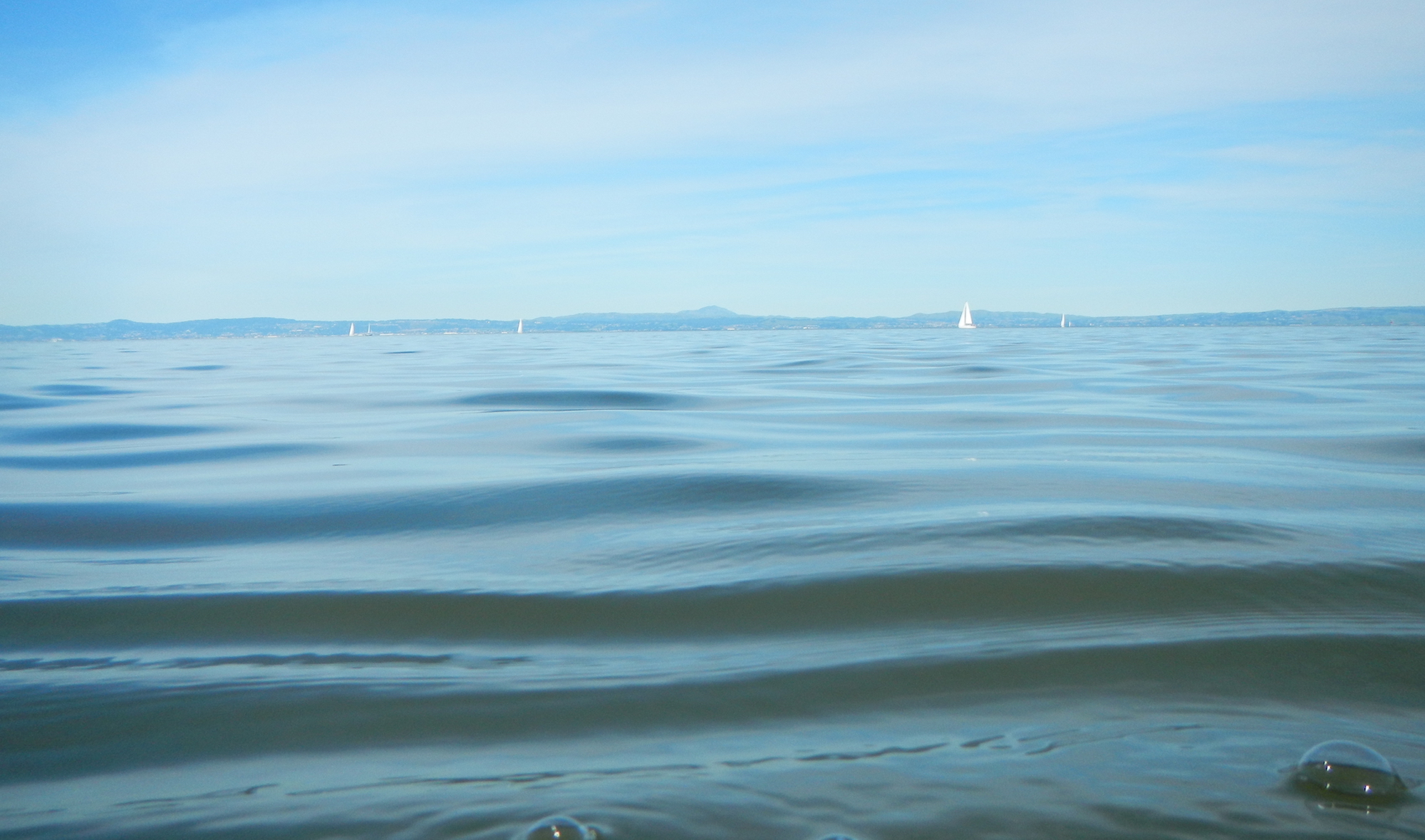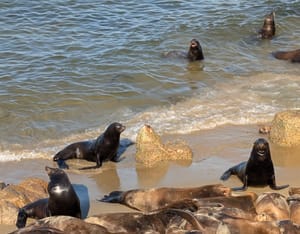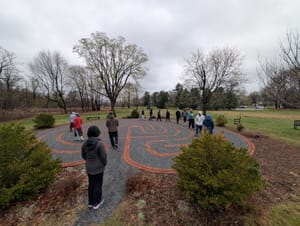Last weekend I entered the water much better prepared than the week before, and managed to swim for two and a half hours. The water temperature varied from 59F-60F, and the morning was fairly calm, overcast giving way to sunny sky. The biggest challenge was the current: We found a significant flood challenging our attempts to swim westward out of the cove, so we gave in and rode the current back east, along the outside of the breakwater, and then came back inside. But even with the shelter from the breakwater, and later inside the cove, the flood was still strong enough that it wreaked havoc with any notion of speed or time. I had to fight my way out to the opening of the cove, but later I had to fight my way in the opposite direction, from the opening back along the ships. Behind the ships the water was sucking me up against the hulls, to the right, but as soon as I emerged from behind a ship the full force of the flood knocked me hard to the left, and I had to swim diagonally to make any headway at all. In all I think I covered about 3.5 miles, which is not much for the time, but plenty given the currents. I felt very good about the swim—it was confidence-boosting.
In my last post I wrote about how changeable the water is, and this weekend was no exception to the rule. But there was one factor I didn’t mention, and that’s human influence.
Humans have been changing water flows in the Bay for a century: Dredging shipping channels, putting in bridge piers that create vortices and outright whirlpools during strong floods and ebbs, filling in parts of the bay and eliminating many of the marshy margins that used to absorb the excess rains or river flows and act as a buffer to the incoming tides. Compared to many estuaries, the SF Bay is still remarkably functional as an ecosystem; it hasn’t been paved or channelized or contained too drastically. There are notable victories: The environmental movement got its start in the 1960s and 1970s here, spearheaded in large part by Berkeley wives, and the organization those women founded, Save the Bay, helped bring about a massive reduction of pollution and trash in the Bay and a huge increase in the amount of publicly-accessible shoreline around the Bay. Peninsula environmentalists helped create a 20,000-acre wildlife refuge in the 1980s. Former salt-drying ponds operated by Cargill are being converted back into marshland, bringing back endangered species.
But there’s one way humans exert massive control over the entire Bay ecosystem, and that’s through the rivers that flow into it. Nearly every river going into the Bay has been dammed at some point upstream, giving the State of California a huge amount of control over how much water makes it down to SF. Much of this water is already diverted to agricultural uses in the Central Valley, or to reservoirs in the East Bay that store water for drinking, for flushing toilets, and for watering lawns. Now, a new proposal championed by the Governor would divert even more water, through underground tunnels, to Southern California.
Called WaterFix, the $17-billion-dollar project’s most prominent feature is the creation of the Delta Tunnels, a pair of long underground tunnels, 30-40 feet in diameter and up to 150 feet underground, that will suck water out of the Sacramento River between Courtland and Clarksburg, and take it 35 miles south, under the entire Delta, to deposit that water in the Clifton Court Forebay, a part of the California Water system that lies between Walnut Creek and Tracy. The water would then flow south through the California aqueduct system, through the Central Valley and potentially as far south as Los Angeles.
The U.S. Fish & Wildlife Service and the National Marine Fisheries Service recently reviewed the plan and gave it a green light, particularly after the inclusion of some habitat restoration in the project. Also, it may be that WaterFix will be better for fish than the current Delta water-capture system, which draws water out of the southern Delta only, sucking up so much water that rivers flow backwards and fish die en masse. The new system will avoid these reverse flows and kill fewer fish, planners say.
But SF Baykeeper has also reviewed the plan and has found a lot of reasons to be concerned. The one that sticks out, to me, is the fact that the Delta is not in good shape to begin with. Algal blooms, the near-extinction of the Delta smelt and the decline of many other native species, and the fact that fresh-water inflows into the Bay have been very low through the drought years are causes for concern. The salmon-fishing season has seen a lot of trouble for the past several years due to low numbers of mature salmon, for instance. Crab seasons in the SF area have also been sharply curtailed or cut off completely in recent years as well.
In that context, sucking even more water out of the rivers that feed the Bay doesn’t seem like a step in the right direction. As Baykeeper’s brief puts it, “The consequences of removing flows from the Sacramento River include ecosystem-scale effects.” (emphasis mine) Even with the habitat restoration and the steps to prevent fish kills, less fresh water in the Bay could lead to long-term changes throughout the entire Bay system: More species declines, increased salinity, more stagnant water, less oxygen-generating phytoplankton.
One of the reasons I am swimming 6.5 miles in Baykeeper’s Bay Parade on July 9 is because I value exactly this kind of work: Careful, systematic, scientific analysis of the ecological consequences of human actions on the SF Bay. The Baykeeper paper is a thoughtful, balanced study — and it recognizes that, while the Bay and Delta ecosystem need help, there’s no easy fix. It also acknowledges the need for Southern California water users to have access to water, and that it’s impossible to return the Delta to some kind of pristine, pre-human-development condition. Instead, Baykeeper proposes a range of specific alternatives to WaterFix: better watershed management, habitat restoration projects, modernization of the delta levee system, better groundwater storage, more conservation, and perhaps a smaller, single-tunnel project instead of the current double tunnel proposal.
SF Baykeeper is a nonprofit and it’s supported largely by donations from people who care about maintaining the high quality of SF Bay for recreation (like swimming!), for beauty, for fishing, and for other reasons. In a time when the EPA is underfunded and the federal government is stripping away laws that protect public water resources, we need nonprofits like this more than ever. Please join me in supporting their work.
Sign up here to follow along as I prepare for my big swim July 9:
[xyz-ihs snippet=”swimform”]



